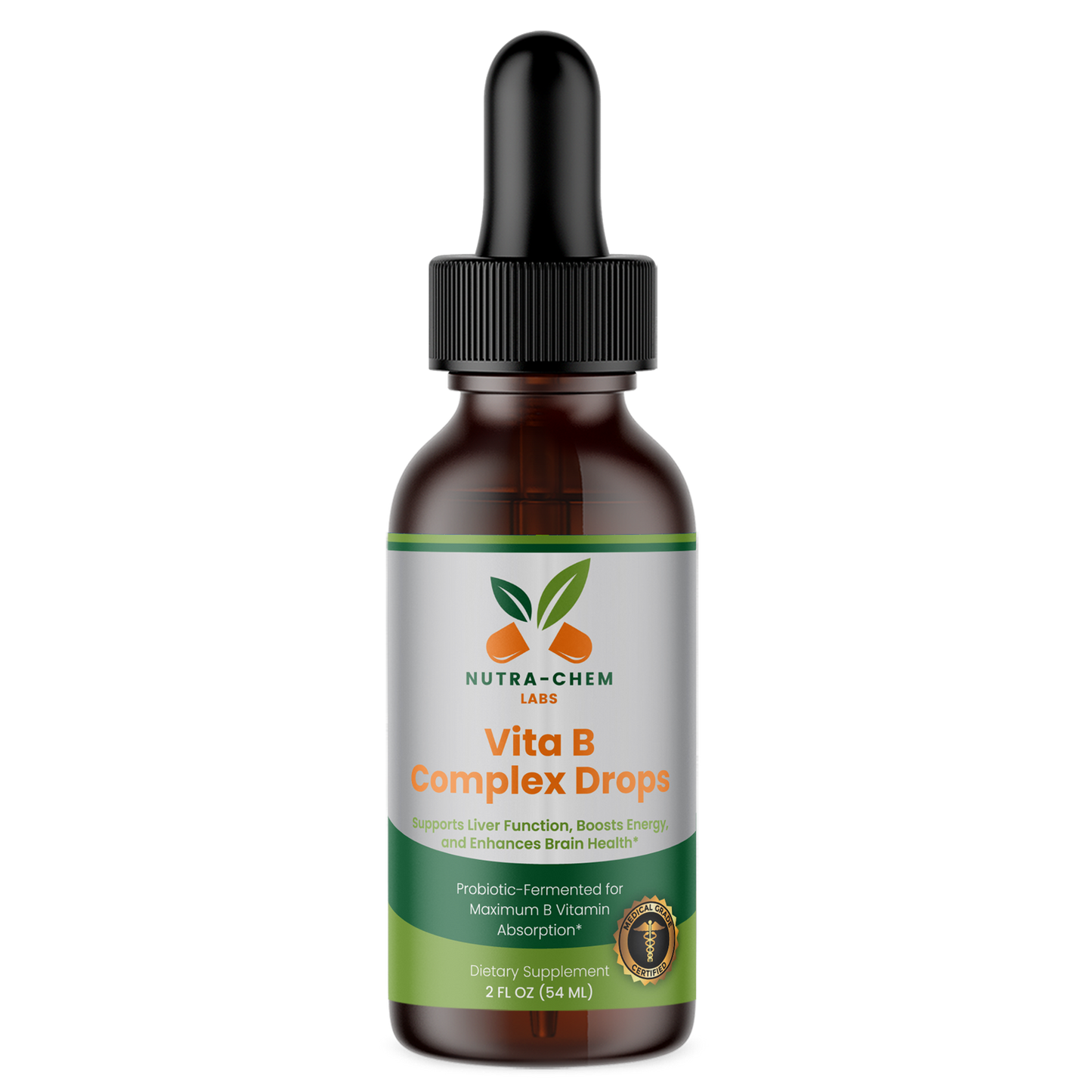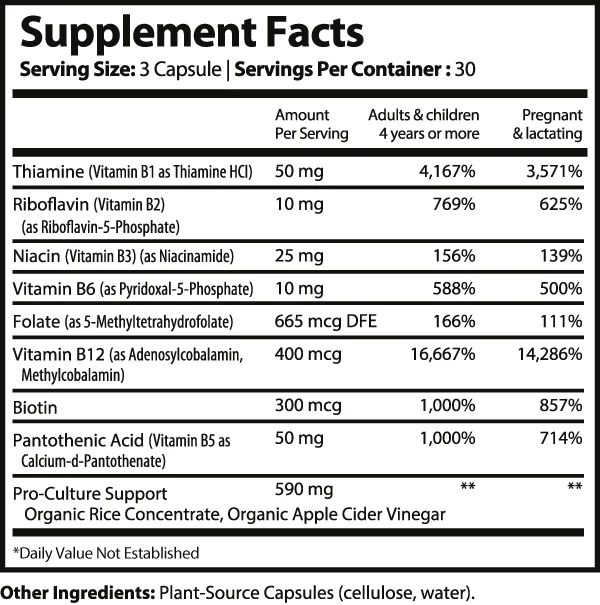- Description
- Key Ingredients & Benefits
- Usage & Directions
- Quality Standards
- Warnings
- Sources
Vita B Complex Drops are expertly formulated using cutting-edge scientific research to promote liver health, immune support, adrenal function, mood balance, stress management, and energy production. This formula features bioavailable, probiotic-fermented B vitamins powered by ND Technology™(Novel Micro-cultured Delivery), enhancing absorption and bioenergetic benefits. Experience noticeable effects from the first dose
Vitamin B1 (Thiamine): Supports nerve function, cardiovascular health, and energy metabolism.
Vitamin B2 (Riboflavin): Boosts red blood cell production, energy metabolism, and activation of other B vitamins.
Vitamin B3 (Niacin): Promotes cardiovascular health, cognitive function, and healthy inflammatory responses.
Vitamin B6: Essential for over 150 enzymatic reactions, blood sugar regulation, and immune support.
Folate (5-MTHF): Aids DNA synthesis and cognitive function, especially for those with MTHFR mutations.
Biotin: Enhances energy metabolism, hair and skin health, and glucose breakdown.
Vitamin B5 (Pantothenic Acid): Improves energy production, memory, and cellular repair.
Take ½ teaspoon daily, mixed with ¼ cup of water or juice. Shake gently before use and refrigerate after opening.
- Independently tested and free from heavy metals and pollutants.
-*These statements have not been evaluated by the Food and Drug Administration. This product is not intended to diagnose, treat, cure, or prevent any disease. -Tamper Seal: Use only if the seal is intact. Consult your health care practitioner if you are pregnant or nursing, taking medications, or have a medical condition, before taking this or any other product. -Store in a cool, dry place. Keep out of reach of children. -Refrigerate after opening.
8. Gasperi, V., Sibilano, M., Savini, I., & Catani, M. V. (2019). Niacin in the Central Nervous System: An Update of Biological Aspects and Clinical Applications. International journal of molecular sciences , 20 (4), 974. https://doi.org/10.3390/ijms20040974
9.Gentilcore D. (2016). Louis Sambon and the Clash of Pellagra Etiologies in Italy and the United States, 1905-14. Journal of the history of medicine and allied sciences , 71 (1), 19–42. https://doi.org/10.1093/jhmas/jrv002
10.Kirkland J. B. (2009). Niacin status and treatment-related leukemogenesis. Molecular cancer therapeutics , 8 (4), 725–732. https://doi.org/10.1158/1535-7163.MCT-09-0042
11.Hoskin, P., Rojas, A., & Saunders, M. (2009). Accelerated radiotherapy, carbogen, and nicotinamide (ARCON) in the treatment of advanced bladder cancer: mature results of a Phase II nonrandomized study. International journal of radiation oncology, biology, physics , 73 (5), 1425–1431. https://doi.org/10.1016/j.ijrobp.2008.06.1950
38. Ueland, P. M., McCann, A., Midttun, Ø., & Ulvik, A. (2017). Inflammation, vitamin B6 and related pathways. Molecular aspects of medicine , 53 , 10–27. https://doi.org/10.1016/j.mam.2016.08.001
39. Bird R. P. (2018). The Emerging Role of Vitamin B6 in Inflammation and Carcinogenesis. Advances in food and nutrition research , 83 , 151–194. https://doi.org/10.1016/bs.afnr.2017.11.004
40. Mascolo, E., & Vernì, F. (2020). Vitamin B6 and Diabetes: Relationship and Molecular Mechanisms. International journal of molecular sciences , 21 (10), 3669. https://doi.org/10.3390/ijms21103669
51. van de Lagemaat, E. E., de Groot, L., & van den Heuvel, E. (2019). Vitamin B12 in Relation to Oxidative Stress: A Systematic Review. Nutrients , 11 (2), 482. https://doi.org/10.3390/nu11020482
52. Romain, M., Sviri, S., Linton, D. M., Stav, I., & van Heerden, P. V. (2016). The role of Vitamin B12 in the critically ill--a review. Anaesthesia and intensive care , 44 (4), 447–452. https://doi.org/10.1177/0310057X1604400410
53. Shipton, M. J., & Thachil, J. (2015). Vitamin B12 deficiency - A 21st century perspective . Clinical medicine (London, England) , 15 (2), 145–150. https://doi.org/10.7861/clinmedicine.15-2-145
65. Bailey, L. B., Stover, P. J., McNulty, H., Fenech, M. F., Gregory, J. F., 3rd, Mills, J. L., Pfeiffer, C. M., Fazili, Z., Zhang, M., Ueland, P. M., Molloy, A. M., Caudill, M. A., Shane, B., Berry, R. J., Bailey, R. L., Hausman, D. B., Raghavan, R., & Raiten, D. J. (2015). Biomarkers of Nutrition for Development-Folate Review. The Journal of nutrition , 145 (7), 1636S–1680S. https://doi.org/10.3945/jn.114.206599
92. Thakur, K., Tomar, S. K., Singh, A. K., Mandal, S., & Arora, S. (2017). Riboflavin and health: A review of recent human research. Critical reviews in food science and nutrition , 57 (17), 3650–3660. https://doi.org/10.1080/10408398.2016.1145104
93. Suwannasom, N., Kao, I., Pruß, A., Georgieva, R., & Bäumler, H. (2020). Riboflavin: The Health Benefits of a Forgotten Natural Vitamin. International journal of molecular sciences , 21 (3), 950. https://doi.org/10.3390/ijms21030950
94. DiNicolantonio, J. J., Niazi, A. K., Lavie, C. J., O'Keefe, J. H., & Ventura, H. O. (2013). Thiamine supplementation for the treatment of heart failure: a review of the literature. Congestive heart failure (Greenwich, Conn.) , 19 (4), 214–222. https://doi.org/10.1111/chf.12037
95. Saedisomeolia, A., & Ashoori, M. (2018).Thiamine in Human Health: A Review of Current Evidences. Advances in food and nutrition research , 83 , 57–81. https://doi.org/10.1016/bs.afnr.2017.11.002
96. Ragaller, V., Lebzien, P., Südekum, K. H., Hüther, L., & Flachowsky, G. (2011). Pantothenic acid in ruminant nutrition: a review. Journal of animal physiology and animal nutrition , 95 (1), 6–16. https://doi.org/10.1111/j.1439-0396.2010.01004.x
213. Mock DM. Biotin: From Nutrition to Therapeutics. J Nutr. 2017 Aug;147(8):1487-1492. doi: 10.3945/jn.116.238956. Epub 2017 Jul 12. PMID: 28701385; PMCID: PMC5525106.
214. Patel DP, Swink SM, Castelo-Soccio L. A Review of the Use of Biotin for Hair Loss. Skin Appendage Disord. 2017 Aug;3(3):166-169. doi: 10.1159/000462981. Epub 2017 Apr 27. PMID: 28879195; PMCID: PMC5582478.
381. Vidmar Golja, M., Šmid, A., Karas Kuželički, N., Trontelj, J., Geršak, K., & Mlinarič-Raščan, I. (2020). Folate Insufficiency Due to MTHFR Deficiency Is Bypassed by 5-Methyltetrahydrofolate. Journal of clinical medicine , 9 (9), 2836. https://doi.org/10.3390/jcm9092836




